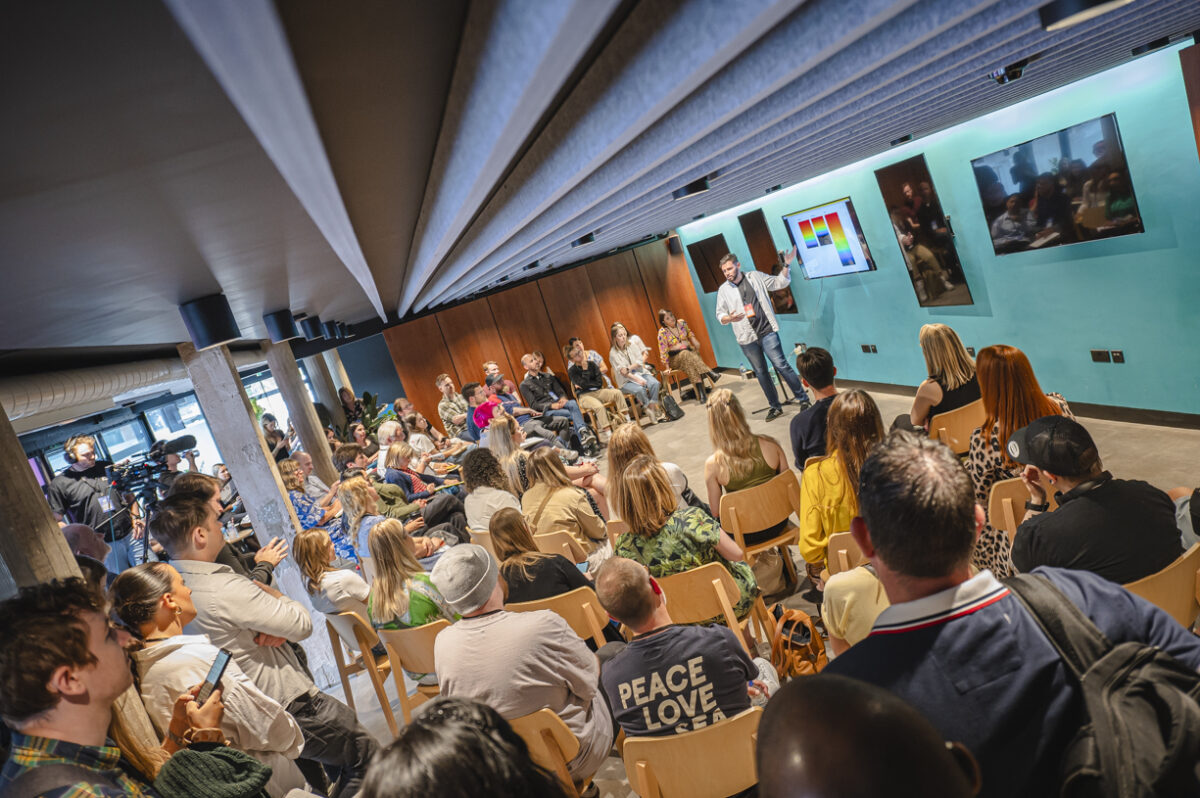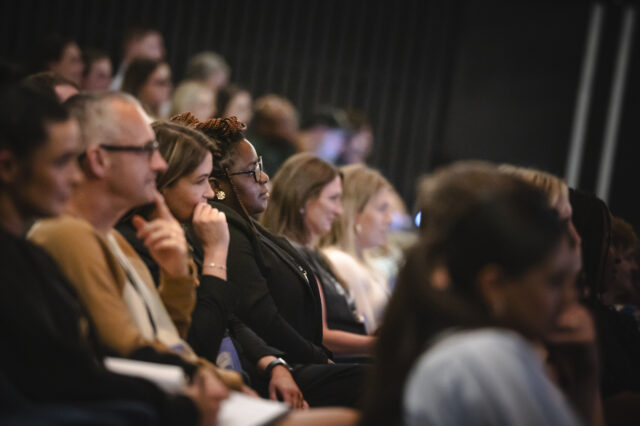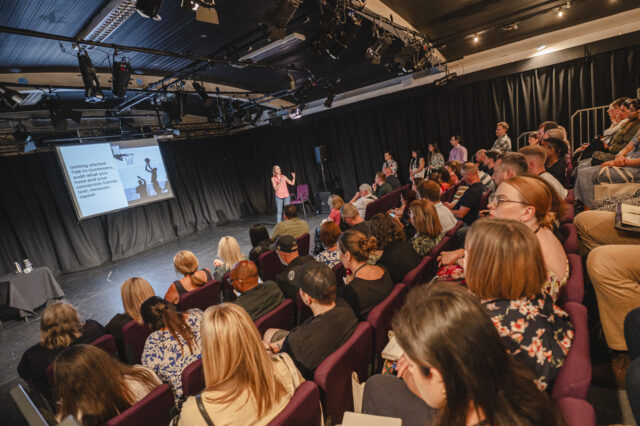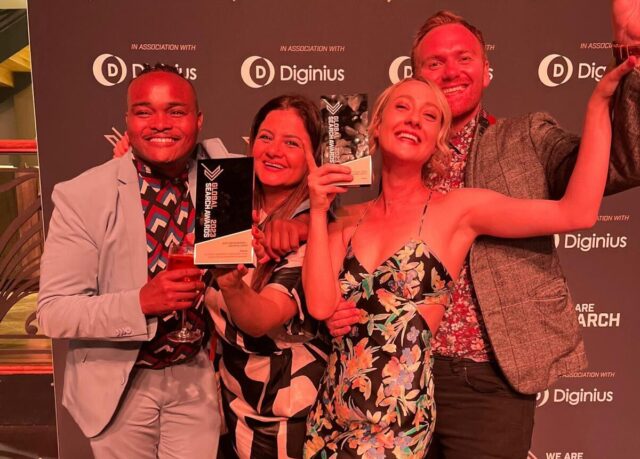This year’s newest third stage at the Nottingham Digital Summit boasted an impressive line-up of speakers, from TUI to Semrush and our own Hallam colleagues.
We know it was a popular stage on the day, so if you couldn’t attend a talk or you just want to learn even more from experts across PR, UX, SEO, social media and more, then we’ve got you covered with all the insights from the Company Room.
What do you mean links aren’t everything? Lessons to be learnt from traditional PR
Alice Preece, Press Officer at TUI, discussed how PR is not all just about backlinks – in fact, the key to PR success is through equating your PR goals with wider business goals. This can be measured as outtakes and outcomes. Outtakes are numerical metrics (number of tweets, content engagements, branded searches etc), and outcomes are the overall impact of the campaign (e.g. awareness, behavioural change).
Measuring awareness and behaviours before, during and after gives real evidence that demonstrates value.
Alice shared just a few of the ways you can start demonstrating value beyond the usual digital metrics of links and social shares, and delve deeper into the purpose of a campaign and the messaging behind it:
- Surveys are a strong way to show the outcomes of a PR campaign
- Sentiment analysis versus competitors is a great way to identify how your share of voice is tracking
- Where are your brand mentions? Are they relevant?
Stop making sh*t websites! How to improve your approach to UX
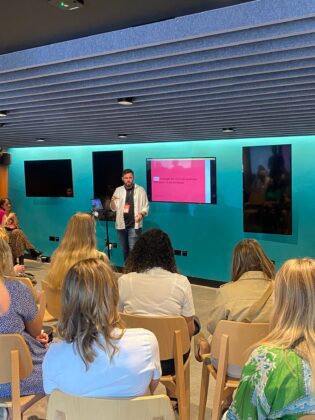
Our Head of Experience, Francis Williams, began his talk with some convincing stats as to why user experience on your website shouldn’t be overlooked:
- 94% of people don’t trust outdated websites
- 70% of online shoppers abandon their carts solely based on a bad user experience
- 39% of people will stop engaging with a website if the image loading time is too slow
To make sure you don’t fall into one of these stats, you have to first understand your users’ mindsets and missions.
Users will engage with you how and when they want, so speak to them to understand what they find preferable and what their pains and goals are. You can do this through: user testing, user interviews, A/B testing, social networking crawling, and so on. Always continue to test and learn – even when you think your website design is finished – and remember that UX is only part of the picture, your content, site speed, visuals and branding – all have an impact on user interaction.
Only once you’ve understood your user and their mission can you design your site accurately.
Why your people are your best marketing asset
Michael Younger, Marketing and Campaigns Manager at Rainbows Hospice, explained that people in your team are the best marketing asset you can use – and this is because they can help you achieve authenticity.
Authenticity is so important in a world consumed by so much content, by generative AI, and the false reality social media can portray. You will gain trust, credibility and connections from your customers if you create an authentic brand voice.
You can get your team involved by asking (as Michael said, it can take a while!), showing them the impact your authentic voice is making, and by empowering them.
How to supercharge your Performance Max campaigns
Simran Harichand, our Paid Media Consultant, took us through the steps to improving Performance Max campaigns so that you can make strategic decisions faster and find where your customers are.
Her four key steps were:
- Product segmentation – this helps you to protect a competitive edge and makes it as clear as possible who you should be targeting.
- Audience signals – tell Google who your ideal customer is by feeding keyword lists, website visitors, past buyers, and competitor websites into your campaign.
- Creative optimisation – your creatives are so important and should be consistent and optimised across all different inventory, including Google search, Gmail, Youtube and so on.
- Use of scripts – human input comes still remains so important for controlling your campaigns. There are plenty of scripts available online written by industry experts that you can start off implementing.
Why are creatives annoying?
Our Creative Lead, Al Davies, answered ‘why are creatives so annoying?’ during his talk.
While to a mere mortal (or a ‘non-creative’, perhaps!) it seems that creatives are incapable of taking a logical ‘top-to-bottom’ approach, Al explained that there is actually a method to their madness. Creatives choose to take an approach referred to as the ‘creative funnel’. Rather than choose the seemingly most logical option, creatives usually create at least three options – some of which may not have even been a consideration – and then filter these down to the most fitting choice. This approach is the best way to create something that will stand out from the noise but can make you feel like you’re being ignored. That’s why it’s so important to get your creatives to show their journey to clients, and not just the end result.
The best way to integrate your creatives into your team is as simple as setting the right briefs.
- Talk to creatives early in the process
- Don’t tell them how long it will take
- Don’t write subjective briefs that are difficult to shift in any approver’s head
- Talk to the client throughout the creative process
Small but mighty: crushing big companies on a tiny budget
Ryan Jones, Marketing Manager at SEO Testing, discussed how finding your competitive advantage is the most effective way to compete against big companies who are selling the same products or services as you.
- Find niche keywords that are easier to rank for and are specific to your brand.
- Provide great customer service and personal connections that are hard to come by with big brands.
- Make room for testing – create a strategy and make sure you’re updating blogs and content for improved organic traffic.
- Spend time (and money) on social media.
From TikTok to top tips: how to win at the game of social media
Leala Jackson, Creative Director at CNS Media’s creative arm, Fork The Waffle, debunked myths and revealed the truths of social media, starting with the rumours that have worked for her:
- You should reply to comments with words, never emojis. Comments create more engagement which helps your posts.
- You need to be on every single social media platform. Go where your customers are.
- Never post the same content across social channels. Each channel has different algorithms and needs.
- Always remove the watermark if you are sharing. The owner of Instagram has confirmed this; always remove the watermark.
Leala dived deeper into her top tips for TikTok were specifically, especially for brands just starting out:
- Create a blank TikTok account and don’t follow or engage; this will give you a non-bias insight.
- Follow #Capcut; this will show you edits and #TrendAlert to see what’s emerging.
- Over 63% of all videos with the highest click-through rate highlight their message in the first 3 seconds.
- Use the TikTok creative centre; it gives you live data for everything!
- Never delete your videos; TikToks can act on delayed explosions, sending an old video through the testing process again.
Sh*t – my organic traffic is dropping! What to do and how to recover
Our SEO Team Lead, Stanley Dunthorne, gave 4 steps to rectify an issue involving a drop in organic traffic.
The first is to work out if your organic traffic has actually dropped – you can do this by checking if traffic has dropped in Google Search Console in the same way it has in Google Analytics. If you see the same pattern in Google Search Console then you have a real traffic drop.
But, before you panic, Stan warned to rule out external factors – things like seasonal changes can change the amount of traffic you’re getting and can be perfectly normal. You can use tools like Google Trends to find out whether there’s a drop in demand for your products, too. But again, using GSC, if rankings are dropping as traffic is dropping, you have a problem.
His next port of call was to go to GSC or GA and compare pre and post traffic drops so you can identify whether the drop is sitewide, or if it’s a case of one missing URL that could have been removed by accident. The drop is sitewide if you see something like a 20% traffic drop across every page.
Once you’ve determined you’ve got a problem, it’s so important to make your website better if you want to improve traffic again. Stan left us with the following advice:
- Make sure website content is relevant and up to date
- Find out why competitors are outranking you
- Ensure every URL adds value
The state (and the future) of search
Erika Varangouli, Head of International Brand at Semrush, sat down with our Head of Organic, Carmen Dominguez, for a Q/A regarding the state of search at the moment and giving their predictions for its future.
The way we search is changing. Social media is increasingly being used as a search tool, desktop is becoming a visual tool and mobile phones are being used for commerical purposes. TikTok is becoming incredibly prominent in the SERPs, with organic rankings increasing by over 1000% YoY.
Erika and Carmen highlighted a slow but visible shift emerging towards more commercial search results, but noticed that search intent has remained namely the same, with queries often consisting of 1 or 2 words. They predicted this could change overtime with new conversational search behaviour.
Search Generative Experience will be the biggest game-changer in search, changing which SERPs users get after typing in a search query. Erika and Carmen gave their best advice for what your strategy should look like when this change comes into play.
- Create helpful content that is relevant to your audience.
- Build your trust signals through reviews, listings, and build your EEAT.
- Build your brand and make sure you’re present where your customers are.
- Think best practice: things like schema and site architecture will still play an important role.
Tough talks by Tough to Talk: shaking up the digital marketing sector
Steve Whittle, founder of men’s suicide prevention charity, Tough to Talk, urged men to reach out for help if they need it and reminded us of how important it is to look out for our colleagues and destroy the stigma around men’s mental health.
Steve pointed out the shocking fact that over 50,000 men in the digital marketing industry are having suicidal thoughts, and over 1 in 20 males in the general population.
Raising awareness of this issue within your own companies may just save someone’s life.
Video and the power of emotion
Jon Mowat, co-founder and Managing Director of Hurricane Media, explained the interesting science around video marketing and how it has such a powerful impact on the human brain.
Your phone is a dopamine pump which activates the same survival traits humans have always had: a longing for human connection, reward after the hunt, a sense of belonging and task completion – videos can create this feeling.
Vision is our predominant sensory interface with the environment – all thanks to primates evolving to have the ability to detect snakes – so humans engage with visual input most.
We have evolved so that most of our decision making is effortless and unconscious – which is driven by emotion. Harnessing the scientific facts of emotion being intertwined with human decision making, and visual input being our preferred way to engage, makes emotive video marketing a clear winner for building a connection with an audience.
Be more Bowie
Personalised Creativity Consultant, Si Beales, related how we can develop business creativity by following similar principles to the rock icon, David Bowie.
The creative process over time is rarely made up of parts which form a whole, it’s often made of separate wholes, which make another whole, and another, until you end up with something completely different. For example, the idea for a car didn’t start with just a set of wheels, it started with a bike, which eventually developed into a car.
The same can be applied to business creativity, many people take inspiration from other businesses and build upon this to make it their own – and surely that must be the right way to do it, because whoever you’re inspired by must be doing something right!
He left us with a quote from Jean-Luc Godard: “It’s not where you take things from. It’s where you take things to.”
Want more insights?
We’ve summarised the main takeaways from our Main Stage speakers and Neville Studio speakers, too.

